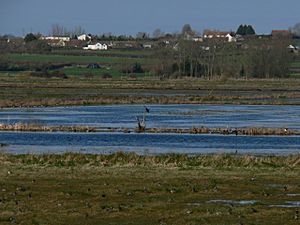West Sedgemoor facts for kids
| Site of Special Scientific Interest | |

A lake at the RSPB West Sedgemoor nature reserve
|
|
| Area of Search | Somerset |
|---|---|
| Coordinates | 51°01′41″N 2°54′45″W / 51.02800°N 2.91256°W |
| Interest | Biological |
| Area | 1,016 hectares (10.16 km2; 3.92 sq mi) |
| Notification | 1983 |
West Sedgemoor is a very special natural area in Somerset, England. It is located about 8 miles (13 km) east of Taunton. This flat, low-lying land is part of the larger Somerset Levels. It is known for its many green fields and meadows. These are separated by water-filled ditches called rhynes. West Sedgemoor is very important for wildlife. Because of this, a large part of it is protected as a Site of Special Scientific Interest (SSSI).
Contents
Exploring West Sedgemoor: A Special Place
West Sedgemoor is a large area of land. It covers about 1,016 hectares (3.9 square miles). It was officially recognized as a Site of Special Scientific Interest (SSSI) in 1983. An SSSI is a place that is protected because it has special plants, animals, or geology.
The Landscape of West Sedgemoor
This area is very flat and low, only about 5 metres (16 feet) above sea level. It is made up of many fields and meadows. These are divided by a network of water channels called rhynes and ditches. In winter, the area is often flooded on purpose. This controlled flooding helps the land and its wildlife. The River Parrett helps to drain the water from the moor.
A Home for Wildlife
Part of West Sedgemoor is a nature reserve managed by the Royal Society for the Protection of Birds (RSPB). This means it is a safe place for many different animals.
Tiny Creatures: Invertebrates
West Sedgemoor is home to many small creatures called invertebrates. These are animals without a backbone. You can find many interesting insects here. This includes rare water beetles, beautiful dragonflies, and various types of bugs. These tiny animals are an important part of the moor's ecosystem.
Birds of West Sedgemoor
The moor is also a fantastic place for birds, especially waterfowl and waders. Waders are birds that often feed in shallow water or on wet ground. Many birds come here to breed and raise their young.
Some of the birds that breed at West Sedgemoor include:
Swell Wood: A Heron Home
On the southern edge of the West Sedgemoor reserve is a place called Swell Wood. This is an ancient deciduous wood. Deciduous trees are trees that lose their leaves in autumn. Swell Wood is famous for having one of the largest heronries in the UK. A heronry is a place where many herons build their nests and raise their chicks. The best time to visit and see the herons is between March and June.

